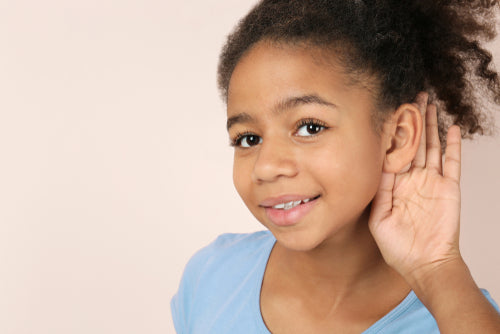
ASMR and Kids: Everything You Need to Know
Anabelle DwyerShare
ASMR, or Autonomous Sensory Meridian Response, is a term you may have heard floating around lately but don't quite know what it is. Don't worry; you're not alone! ASMR has become relatively popular in mainstream media over the past few years, but isn't commonly associated with children and early learning. In this blog post, we'll discuss everything you need to know about ASMR - what it is, how it works, and the benefits of experiencing it. We'll also examine the pros and cons of ASMR with kids. So, if you're curious about this intriguing phenomenon, read on!
The videos that make your skin tingle and break out in goosebumps? They're called ASMR, or autonomous sensory meridian response. It's a form of relaxation where you listen to relaxing sounds like whispering or tapping on different surfaces with fingers until it feels too much to handle—and then there are these amazing moments when something triggers another kind entirely: powerful, pleasant sensations running up both arms while listening closely, for instance, might lead into an episode where everything else seems far away yet still accessible at once; after a while we find ourselves sitting back with a little less stress or anxiety.
It's been said that ASMR videos can help kids’ mental health, from potentially easing anxiety to providing a relaxing soundtrack for studying. While this is not an overnight cure-all, and there has initially been some skepticism about whether these types of content could provide any relief at all without simply being another YouTube trend like other popular trends such as slime races or dog DIY tutorials (both also proven effective), it seems reasonable enough given recent research into the subject by universities around America which shows promise in proving its effectiveness.
According to Alysia Thomas, an occupational therapist at Kids in Motion Pediatric Therapy, which has facilities in Highland, Clarkston, Commerce Township, and Brighton, ASMR has similarities to a traditional Chinese medicine concept known as "meridians." Meridians are energy routes or "body highways" that run through our bodies. Some people refer to them as "chakras." ASMR is the rapid response to stimulation of the meridian in the skull and spine, often known as the "crown chakra." Visual, aural, and tactile inputs cause these experiences. Another reason ASMR may naturally appeal to children? It simulates some of the experiences that newborns get while connecting with their mothers and fathers.
Kids love ASMR, but is it safe?
Many studies have shown how children's media affects their mental health in the past few years. One area that has come under scrutiny involves YouTube videos with titles like "ASMR Success Stories" and sprawling tutorials on crafting your own 'tingles' by adding sound effects into video edits or creating music using only mouse clicks - all without any visual stimulation whatsoever! It was also discovered these were being watched closely by teens aged 12–19, who reported feeling less stressed after watching them than those witnessed interacting socially. YouTube is made of some videos that are popular with kids. But as any parent knows, monitoring your child's screen time can be challenging!
It's important for parents and guardians of kids who enjoy the sensory benefits from this type of media but wish it was more engaging in nature or had other positive effects like learning skills development opportunities (like building confidence), so they can decide if it’s good or not -based solely upon those factors without consideration given towards any potential risks associated with playing such games online when there isn't an adult present at home providing oversight--which some experts fear might lead youth into dangerous situations since young people lack maturity levels necessary.
Before using ASMR, rule out the bigger issues.
It's important to note that ASMR can have different outcomes as people differ. This means there may be risks associated with it for people with undiagnosed sensory integration disorders, such as kids on this list - including those trying desperately to fight off sleep deprivation!
In instances where your child displays behavior like being agitated by seams and tags in clothing (or any other type), crashing into things eagerly even if they're stationary; or showing signs of constant motion sickness while watching calming videos online--you should get them evaluated first before endeavoring down an extra rabbit hole via YouTube searches.
Specific techniques like repetitive sounds, movements, or textures might cause “seeking behavior." This means that if they are done inconsistently, then it will lead your child to more problems with Special Needs services. However, this cannot be applied to all children as some people have very different needs when going through therapy, depending on their specific mental health issues.
Maintaining perspective when monitoring ASMR and children.
Remember a few key things if you want your children (or other people) to watch ASMR videos. For starters, safety on YouTube—the main conduit for these experiences--is paramount! As with any video content out there that has kids' attention spans limited by time constraints and boredom levels inherent within their age range; be mindful about what they see while browsing through pages of different clips available online- especially those containing adult language or themes which might not appeal equally across all demographics depending upon how old someone gets.
Kids’ safety on YouTube is a concern. There are over 10 million ASMR videos available, but some may be questionable or suggestively geared towards adults, which you need to watch out for when browsing with your children in front of the screen! Make sure they're supervised while scrolling through these channels and never auto-play anything without checking first yourself - it's just not worth endangering their young minds any longer than necessary.
And lastly, take ASMR with a grain of salt. After all, not everyone experiences these tingle sensations. While it has grown in popularity, there's no way for us to know if your child is experiencing this because they love YouTube or if you really should be looking into some other reasons as well, such as finding out what could have caused their discomfort when watching specific videos.
If you want to skip the ASMR, don't worry! There are many other ways your child might find relief from their symptoms. For example, backrubs, soft fabrics, or even tactile toys that help with sensory stimuli, such as BunMo’s Super Sensory Strings or Super Sensory Stress Balls!
